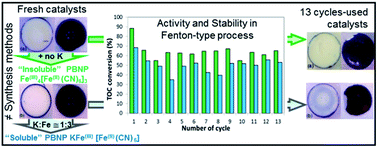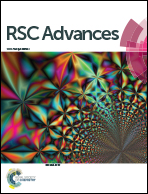“Soluble” vs. “insoluble” Prussian blue based catalysts: influence on Fenton-type treatment†
Abstract
The influence of the synthesis procedure of supported Prussian blue nanoparticles (PBNP) on their activity and stability as a Fenton-type catalyst is studied. Hence, two catalysts are synthesized by adsorbing onto a support of PBNP formed ex situ through the reaction between FeCl3 and K3Fe(CN)6 using H2O2 as reducing agent, and following different washing protocols. A third catalyst is prepared through a two-step impregnation process with FeCl3 and K4[Fe(CN)6] aqueous solutions. The catalysts are tested in the orange G Fenton-type oxidation. The fresh and used catalysts are characterized by BET surface area, SEM, EDS, TEM, Mössbauer spectroscopy, total iron content and UV-vis spectrophotometry. It is demonstrated that under the synthesis conditions employed, the “insoluble” form of Prussian blue is promoted in the ex situ procedure, whereas the two-step impregnation process leads to the “soluble” Prussian blue formation. The washing of the just-prepared catalysts at the reaction temperature helps in eliminating the unreacted species. Those catalysts based on “insoluble” Prussian blue nanoparticles exhibit better behaviour in terms of stability. Significant removals are attained (100% azo dye, 60% TOC), at pH = 3, 343 K after thirteen successive cycles of 300 min. The best catalyst displays the smallest amount of total “free” Fe leached without releasing PBNP, ferrocyanide or ferricyanide ions into the reaction media. Reversible adsorption–desorption of organic intermediates avoids the loss of activity due to blockage of sites and/or pores.


 Please wait while we load your content...
Please wait while we load your content...